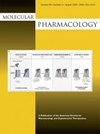Signaling specificity and kinetics of the human metabotropic glutamate receptors
IF 3.2
3区 医学
Q2 PHARMACOLOGY & PHARMACY
引用次数: 0
Abstract
Metabotropic glutamate receptors (mGluRs) are obligate dimer G protein coupled receptors that can all function as homodimers. Here, each mGluR homodimer was examined for its G protein coupling profile using a BRET based assay that detects the interaction between a split YFP-tagged Gβ1ᵯE;2 and a Nanoluciferase tagged free GβᵯE; sensor, MAS-GRK3-ct-NLuc with 14 specific G⍺ proteins heterologously expressed, representing each family. Canonically, the group II and III mGluRs (2&3, and 4, 6, 7&8, respectively) are thought to couple to Gi/o exclusively. In addition, the group I mGluRs (1&5) are known to couple to the Gq/11family, and generally thought to also couple to the PTX-sensitive Gi/o family; some reports have suggested Gscoupling is possible as cAMP elevations have been noted. In this study, coupling was observed with all 8 mGluRs through the Gi/o proteins, and only mGluR1&5 through Gq/11, and perhaps surprisingly, not G14. None activated any Gs protein. Interestingly, coupling was seen with the group I and II, but not the group III mGluRs to G16. Slow but significant coupling to Gz was also seen with the group II receptors.人类代谢型谷氨酸受体的信号特异性和动力学
变态谷氨酸受体(mGluRs)是必须的二聚体 G 蛋白偶联受体,它们都可以作为同源二聚体发挥作用。在这里,使用一种基于 BRET 的检测方法检测了每种 mGluR 同二聚体的 G 蛋白偶联情况,该方法检测分裂的 YFP 标记 Gβ1ᵯE;2 和纳米荧光素酶标记的游离 GβᵯE;传感器 MAS-GRK3-ct-NLuc 与异源表达的 14 种特定 G⍺蛋白(代表每个家族)之间的相互作用。一般认为,第二和第三类 mGluRs(分别为 2&3 和 4、6、7&8)只与 Gi/o 结合。此外,已知第 I 组 mGluRs(1&5)可与 Gq/11 家族耦合,一般认为也可与 PTX 敏感的 Gi/o 家族耦合;一些报告指出,Gscoupling 是可能的,因为已注意到 cAMP 升高。在这项研究中,观察到所有 8 个 mGluRs 都通过 Gi/o 蛋白耦合,只有 mGluR1&5 通过 Gq/11 耦合,令人惊讶的是 G14 没有耦合。没有一个能激活任何 Gs 蛋白。有趣的是,I 组和 II 组 mGluRs 与 G16 发生耦合,但 III 组 mGluRs 与 G16 没有耦合。第二组受体与 Gz 的耦合虽然缓慢,但也很明显。
本文章由计算机程序翻译,如有差异,请以英文原文为准。
求助全文
约1分钟内获得全文
求助全文
来源期刊

Molecular Pharmacology
医学-药学
CiteScore
7.20
自引率
2.80%
发文量
50
审稿时长
3-6 weeks
期刊介绍:
Molecular Pharmacology publishes findings derived from the application of innovative structural biology, biochemistry, biophysics, physiology, genetics, and molecular biology to basic pharmacological problems that provide mechanistic insights that are broadly important for the fields of pharmacology and toxicology. Relevant topics include:
Molecular Signaling / Mechanism of Drug Action
Chemical Biology / Drug Discovery
Structure of Drug-Receptor Complex
Systems Analysis of Drug Action
Drug Transport / Metabolism
 求助内容:
求助内容: 应助结果提醒方式:
应助结果提醒方式:


